科技英语写作第二讲-数词和介词
- 格式:ppt
- 大小:680.00 KB
- 文档页数:39
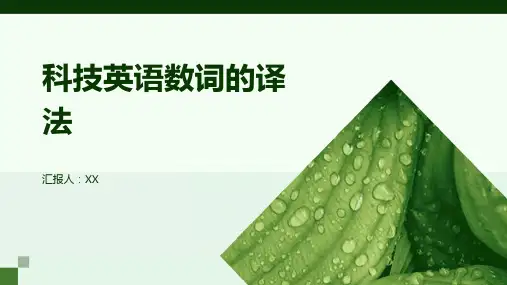

数词1. 定义:表示"多少"和"第几"的词,叫数词。
其用法相当于名词或者形容词。
数词分为基数词和序数词两种。
基数词: 表示数目的词是基数词,最基本的数词如下:1 one,2 two,3 three,4 four,5 five,6 six,7 seven,8 eight,9 nine, 10 ten, 11 eleven, 12 twelve, 13 thirteen, 14 fourteen, 15 fifteen, 16 sixteen, 17 seventeen,18 eighteen, 19 nineteen, 20 twenty, 30 thirty, 40 forty, 50 fifty, 60 sixty,70 seventy, 80 eighty, 90 ninety,100 a hundred,1,000 a thousand, 1,000,000 a million,1,000,000,000 a billion.基数词1-12 是独立单词,需逐个记忆。
基数词13 - 19是个位数词的词干后加-teen 构成。
其中thirteen, fifteen, eighteen, 变化不规则。
基数词20 ━90 是在十位数词后面加-ty 构成。
基数词21 ━ 99 是在十位数词后面加上个位数词合成,中间加上连字符" ━ " 。
例如:21 twenty ━ one 95 ninety ━ five基数词三位以上的数词, 在百位和十位之间,一般要用连词"and "。
例如:132 one hundred and thirty ━ two.1340 one thousand three hundred and forty表示"万"的词英语中没有.如1万可用10千来表示。
ten thousand. 30万可用three hundred thousand 来表示。

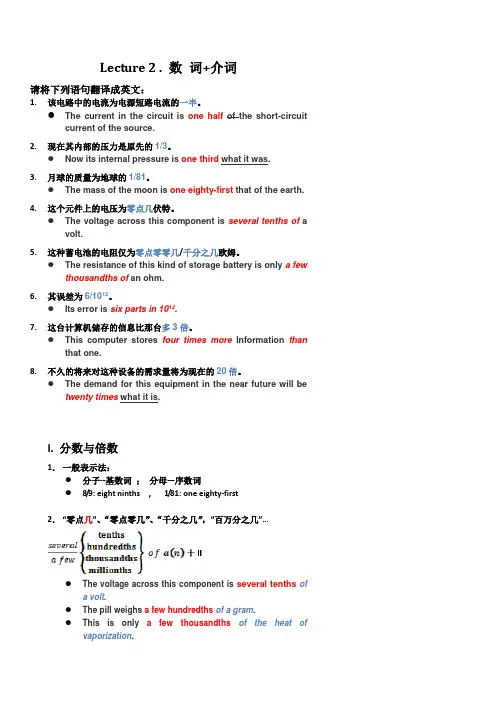
Lecture 2 . 数词+介词请将下列语句翻译成英文:1.该电路中的电流为电源短路电流的一半。
●The current in the circuit is one half of the short-circuitcurrent of the source.2.现在其内部的压力是原先的1/3。
●Now its internal pressure is one third what it was.3.月球的质量为地球的1/81。
●The mass of the moon is one eighty-first that of the earth.4.这个元件上的电压为零点几伏特。
●The voltage across this component is several tenths of avolt.5.这种蓄电池的电阻仅为零点零零几/千分之几欧姆。
●The resistance of this kind of storage battery is only a fewthousandths of an ohm.6.其误差为6/1012。
●Its error is six parts in 1012.7.这台计算机储存的信息比那台多3倍。
●This computer stores four times more Information thanthat one.8.不久的将来对这种设备的需求量将为现在的20倍。
●The demand for this equipment in the near future will betwenty times what it is.I. 分数与倍数1.一般表示法:●分子--基数词;分母—序数词●8/9: eight ninths , 1/81: one eighty-first2.“零点几”、“零点零几”、“千分之几”,”百万分之几”…●The voltage across this component is several tenths ofa volt.●The pill weighs a few hundredths of a gram.●This is only a few thousandths of the heat ofvaporization.●Seven parts per million●Seven parts in a million●Seven parts in 106.3.数词在句子中作前置修饰语●The output is 100 times {of} the input.●Its speed is three times that of the light.●The force excerted on the body is two fifths what it was. 4.表示数量增长/减少的常用句型1.n times + 比较级=n times as 原级as●This box is six times heavier than that one.●This value is nearly 4.5 times greater than the ideal one.●The wavelength of this musical note is over three timeslonger than that of the same note in the air.●The sample has been magnified by a factor of 11. (增了10倍,为原来的11 倍)●If the radius is halved, the flow rate is reduced by afactor of 5. (降低了4倍,降为原来的1/5)请根据中文原文改正英文译文的错误。
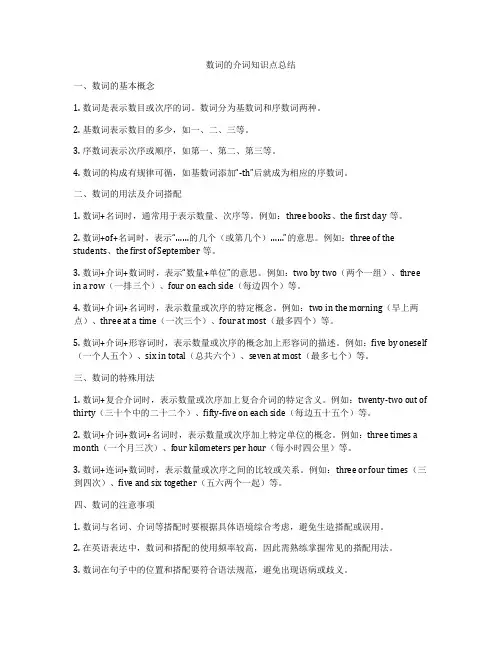
数词的介词知识点总结一、数词的基本概念1. 数词是表示数目或次序的词。
数词分为基数词和序数词两种。
2. 基数词表示数目的多少,如一、二、三等。
3. 序数词表示次序或顺序,如第一、第二、第三等。
4. 数词的构成有规律可循,如基数词添加“-th”后就成为相应的序数词。
二、数词的用法及介词搭配1. 数词+名词时,通常用于表示数量、次序等。
例如:three books、the first day等。
2. 数词+of+名词时,表示“……的几个(或第几个)……”的意思。
例如:three of the students、the first of September等。
3. 数词+介词+数词时,表示“数量+单位”的意思。
例如:two by two(两个一组)、three in a row(一排三个)、four on each side(每边四个)等。
4. 数词+介词+名词时,表示数量或次序的特定概念。
例如:two in the morning(早上两点)、three at a time(一次三个)、four at most(最多四个)等。
5. 数词+介词+形容词时,表示数量或次序的概念加上形容词的描述。
例如:five by oneself (一个人五个)、six in total(总共六个)、seven at most(最多七个)等。
三、数词的特殊用法1. 数词+复合介词时,表示数量或次序加上复合介词的特定含义。
例如:twenty-two out of thirty(三十个中的二十二个)、fifty-five on each side(每边五十五个)等。
2. 数词+介词+数词+名词时,表示数量或次序加上特定单位的概念。
例如:three times a month(一个月三次)、four kilometers per hour(每小时四公里)等。
3. 数词+连词+数词时,表示数量或次序之间的比较或关系。
例如:three or four times(三到四次)、five and six together(五六两个一起)等。

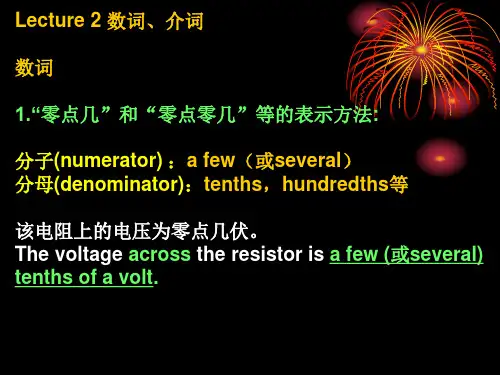

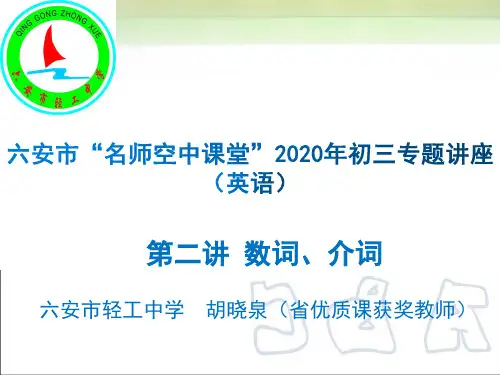
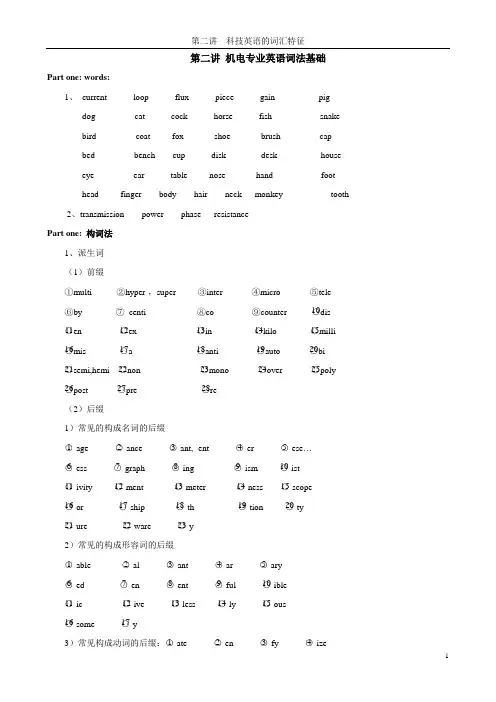
第二讲机电专业英语词法基础Part one: words:1、current loop flux piece gain pigdog cat cock horse fish snakebird coat fox shoe brush capbed bench cup disk desk houseeye ear table nose hand foothead finger body hair neck monkey tooth2、transmission power phase resistancePart one: 构词法1、派生词(1)前缀①multi- ②hyper-,super ③inter- ④micro- ⑤tele-10dis-⑥by- ⑦centi- ⑧co- ⑨counter- ○○11en- ○12ex- ○13in- ○14kilo- ○15milli- 16mis- ○17a- ○18anti- ○19auto- ○20bi-○21semi,hemi ○22non- ○23mono- ○24over- ○25poly- ○26post- ○27pre- ○28re-○(2)后缀1)常见的构成名词的后缀○1-age ○2-ance ○3-ant, -ent ○4-er ○5-ese…○6-ess ○7-graph ○8-ing ○9-ism ○10-ist○11-ivity ○12-ment ○13-meter ○14-ness ○15-scope16-or ○17-ship ○18-th ○19-tion ○20-ty○21-ure ○22-ware ○23-y○2)常见的构成形容词的后缀○1-able ○2-al ○3-ant ○4-ar ○5-ary○6-ed ○7-en ○8-ent ○9-ful ○10-ible○11-ic ○12-ive ○13-less ○14-ly ○15-ous16-some ○17-y○3)常见构成动词的后缀:○1-ate ○2-en ○3-fy ○4-ize4)常见的构成副词的后缀:○1-ly ○2-wards ○3-wise2、合成词1)合成名词○1名词+名词○2名词+动名词○3动名词+名词○4形容词+名词○5动词+名词○6副词+动词○7动词+副词2)合成形容词○1名词+现在分词○2名词+过去分词○3形容词+现在分词○4形容词+过去分词○5形容词+名词○6形容词+名词+ed○7形容词+形容词○8数词+名词○9数词+名词+ed10副词+现在分词○11副词+过去分词○12介词或副词+名词○3)合成动词:○1名词+动词○2形容词+动词○3副词或介词+动词3、转化法1)名词转化为动词2)动词转化为名词3)形容词转化为名词4、缩略词1)节略词(clipped words):maths, ad, dir, lab2)首字母(Initials):CAD, CAM, CAE, VM, QIS, DB, ES, CPU, DBMS,CGA,ROM, RAM3)缩写词(Abbreviation):e.g., Ltd., sq.5、拼缀法:programmatic,telecamera,comsat,forexPart three: Drills:1 There is no physical contact between tool and work piece.2 Public opinion is demanding more and more urgently that something must be done about noise.3 There is a wide area of performance duplication between numerical control and automatics.4 High-speed grinding does not know this disadvantage.5 You found that, in two experiments, hardness and greenness in apple went together with sourness.6 Gasses differ from solids in that the former has greater compressibility than the latter.7 The instrument is characterized by its compactness, and portability.8 The cutting tools must be strong, tough, hard and wear resistant.9 Dynamics is divided in to statics and kinetics, the former treating of force in equilibrium, the latter of the relation of force to motion.10 The image must be dimensionally correct11 The application of electronic computers makes for a tremendous rise in labor productivity.12 In any machine input work equals output work plus work done against friction.13 Scientists are confident that all matter is indestructible.14 Open the valve to let air in.15 It is a fact that no structural material is perfectly elastic.16 They said that such knowledge is needed before they develop a successful early warning system for earthquakes.17 A continuous increase in the temperature of the gas confined in a container will lead to a continuous increase in the internal pressure with in the gas.18 it is our great pleasure to note that China will sooner join the WTO.19 Like charges repel, while unlike charges attract.Things like air, water or metals are matter.Like knows like.I hope I can use the computer like you do.Do you like this color TV set?20 The instrument is very light.The cover of the meter is light blue.。
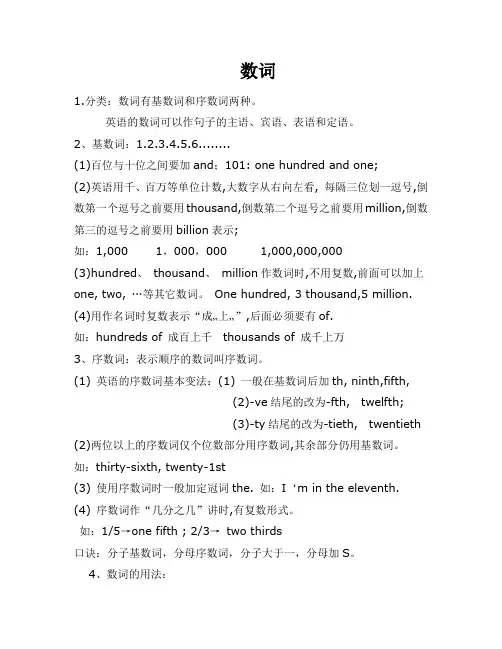
数词1.分类:数词有基数词和序数词两种。
英语的数词可以作句子的主语、宾语、表语和定语。
2、基数词:1.2.3.4.5.6........(1)百位与十位之间要加and;101: one hundred and one;(2)英语用千、百万等单位计数,大数字从右向左看, 每隔三位划一逗号,倒数第一个逗号之前要用thousand,倒数第二个逗号之前要用million,倒数第三的逗号之前要用billion表示;如:1,000 1,000,000 1,000,000,000(3)hundred、thousand、million作数词时,不用复数,前面可以加上one, two, …等其它数词。
One hundred, 3 thousand,5 million.(4)用作名词时复数表示“成…上…”,后面必须要有of.如:hundreds of 成百上千thousands of 成千上万3、序数词:表示顺序的数词叫序数词。
(1) 英语的序数词基本变法:(1) 一般在基数词后加th, ninth,fifth,(2)-ve结尾的改为-fth, twelfth;(3)-ty结尾的改为-tieth, twentieth (2)两位以上的序数词仅个位数部分用序数词,其余部分仍用基数词。
如:thirty-sixth, twenty-1st(3) 使用序数词时一般加定冠词the. 如:I‘m in the eleventh.(4) 序数词作“几分之几”讲时,有复数形式。
如:1/5→one fifth ; 2/3→two thirds口诀:分子基数词,分母序数词,分子大于一,分母加S。
4、数词的用法:(1)表示年份:2002: twenty thousand and two(2)表示日期:2002年11月8日: Nov. 8th, 2002.(3)表示时刻:5:15→five fifteen(4)表示编号:Room 105→Room one 0 five;5、小数的读法:5.7→five point seven, 0.16 →zero point one six.6、“半”的表达:1/2→half, 半小时→half an hour,当堂训练:完成下列句子。
一、数词讲解1、基数词。
表示数目的多少,如:one, two, three, one hundred, two thousand 等。
2、序数词。
表示顺序第几,其前面须加上定冠词the。
如:the twenty-first, the thirtieth等练习:写出下列数字的基数词和序数词的表示方法。
3、分数。
分数表达法:基数词表示分子,序数词表示分母,如果分子大于1时,分母要加“s”。
如:one-fourth, two-fifths, three-tenths4、年、月、时间表达法:年份用基数词,日期用序数词,时间用基数词,其顺序由小到大。
Eg: He was born on January 11th, 1886. He was born in January, 1990.5、Hundred, thousand, million, dozen, score这些词前面如有表示具体数字的词,它们不能加“s”,反之则须加“s”。
如:three hundred people, thousands of people。
(1) 200 个学生____________________________ (2) 成百上千的人__________________________(3) There are about two _______ students in their school.A. thousand ofB. thousands ofC. thousandD. thousands(4) _______ Iraqi people died in the Iraq War.A. Thousand ofB. Thousands ofC. ThousandD. Thousands(5) _______ students in our school went there this summer.A. Two hundredB. Two hundredsC. Two hundreds ofD. Two hundred of基础练习:(1)He lives on _______ floor. A. four B. fourth C. the four D. the fourth(2) Today she is very happy,because it is her ________ birthdayA. seventeenB. seventeenthC. the seventeenthD. the seventeen (3) This is a big class, and ________ of the students are girls.A. two thirdB. second threeC. two thirdsD. two three(4) -- What is one fourth and a half, do you know? -- Yes, it’s _______.A. two sixthsB. three fourthsC. one threeD. three sixths(5) I like this kind of pen, could you please give me _______ more.A. twoB. secondC. the twoD. the second(6) He has failed many times, but he wants to try _________ time.A. sixthB. a sixthC. the sixthD. six(7) In the final exam, he got _______ prize.A. thirdB. the thirdC. threeD. the three二、介词的用法(一) 介词的功能介词是一种虚词,不能单独使用。
英语数词的分类和用法表示数目多少或顺序多少的词叫数词,数词分为基数词和序数词。
表示数目多少的数词叫基数词;表示顺序的数词叫序数词。
接下来,小编给大家准备了英语数词的分类和用法,欢迎大家参考与借鉴。
英语数词的分类和用法一、基数词1)基数词写法和读法:345 three hundred and forty-five;2)基数词一般是单数形式,但下列情况,常用复数:a. 与of 短语连用,表示概数,不能与具体数目连用,如scores of people 指许多人;b.在一些表示“一排”或“一组”的词组里;如:They arrived in twos and threes. 他们三三两两的到达了。
c. 表示“几十岁”;d. 表示“年代”,用 in +the +数词复数;e. 在乘法运算的一种表示法里,如:3 x 5 = 15 Three fives is(are)fifteen.二、序数词序数词的缩写形式:first—1st second—2nd thirty-first—31st三、数词的用法1)倍数表示法a. 主语+谓语+倍数(或分数)+ as + adj. + asI have three times as many as you. 我有你三倍那么多。
b. 主语+谓语+倍数(分数)+ the size (amount,length…) of…The earth is 49 times the size of the moon. 地球是月球的49倍。
c. 主语+谓语+倍数(分数)+ 形容词(副词)比较级+ than…The grain output1 is 8 percent higher this year than that of last year.今年比去年粮食产量增加8%。
d. 还可以用by+倍数,表示增加多少倍The production of grain has been increased by four times this year.今年粮食产量增加了4倍。
第2讲介词和数词常考点解读一、介词1.理解表示地点、时间、方式等的常用介词用法。
2.理解和掌握介词与名词、动词、形容词等常用搭配及用法。
二、数词1.理解基数词和序数词的基本用法。
2.正确使用日期、钟点和年龄等的表示方法。
易混点突破一、介词1.时间介词的用法(1)时间介词in,on,at,by的用法①介词in用来表示一天中某段时间,指天、年、月、季节、周次等j如:in the morning。
②介词on用来表示某一天或星期几,指明具体的时间。
如:on a rainy day。
③介词at用来表示特定的时间、节日、年龄等。
如:at noon,at 7 o’clock。
④介词by表示到某一时间为止。
如:You must come back by 2 o’clock.(2)时间介词in与after的用法①介词in+一段时间用于一般将来时。
如:We’ll go to school in two weeks.②介词after+一段时间用于一般过去时。
如:My mother came home after half an hour.(3)时间介词for与since的用法①介词for表示一段时间。
如:I have been living here for lo years.②介词since表示从过去某一时间以来。
如:I have been living here since 2000.(4)时间介词before与by的用法①介词before表示“在……之前”。
如:He won’t come back before five.②介词by表示“到……时为止,不迟于……”。
如:The work must be finished by Friday.(5)时间介词till与until的用法①till和until用在肯定句中,均可表示“直到……为止”,如:I will wait till(until)seveno’clock..②till和until用在否定句中,均可表示“在……以前”或“直到……才”。
数词包括基数词和序数词两大类。
基数词1.1—12的基数词是独立的单词,即:one,two,three,four,five,six,seven,eight,nine,ten,,。
2.13—19的基数词以-teen结尾。
如:fourteen,seventeen等,但13,15,18较特殊,13—15—18—。
3.20—90的整十位均以-ty结尾。
如:sixty,seventy,但20,30,40,50,80,90较特殊,20—30—40—50—80—90—。
4.十位数与个位数之间要加连字符号“-”,如:28—twenty-eight,96—ninety-six。
5.百位和十位(若无十位则和个位)之间加and,如:148—one hundred and forty-eight 406—four hundred and six。
6.hundred(百),(千),(百万),billion(十亿)等前面即使有具体的数词,也不能在它们的后面加s。
如:600—six hundred,8百万—eight million。
7.1000以上的数字,从后往前数每三位加一个逗号“,”第一个逗号前为千(thousand),第二个逗号前为百万(million),第三个逗号前为billion (十亿)。
英语中无“万”这个词,我们可以用“几十个千(thousand)”表示几万,“几百个千(thousand)”表示“几十万”。
如:2,510=two thousand five hundred and ten;84,296=eight-four thousand two hundred and ninety-six;274,350=88,065,909=。
8.hundred,thousand,million 用复数形式修饰名词时要用“of+复数名词”,如:数以百计的年轻人hundreds of young people;数以千计的书thousands of books。
数词的用法本代主要讲解数词的用法,包含基数词,序数词,分数,小数,百分数,数词加减法等内容,里面还有一些数词记忆小技巧哦,很不错的,最后还有一些数词的练习题一、概述表示数目与顺序的词,叫做数词(numeral)。
数词有两种:基数词和序数词。
数词与不定代词相似,其用法相当于形容词或名词。
可以在句中充当句子成分,如可用作主语、定语、宾语、介词宾语、表语、同位语或状语等。
One added to six is seven.六加一等于七。
(基数词作主语)二、基数词表示数目的词是基数词(cardinal numeral),如one(一),two(二),thirty(三十)等。
1、最基本的基数词2、其它基数词(1)21-99先“几十”再”几”,中间加连字符。
21 twenty-one 25 twenty-five 99 ninety-nine(2)100及100以上的基数词100及100以上的基数词,以末位向前推(每三位一节),依次须用到hundred, thousand, million, billion等。
(3)基数词的读法①三位数的读法:第一个数字+hundred+ and+后面的一位或两位数字101→ one hundred and one 450→ four hundred(and)fifty②1,000以上的数的读法:先从后向前数,每三位数加一个逗号,第一个逗号前的数字用thousand(千),第二个逗号前的数字用million(百万),用“几十thousand”表示“几万”,以“几百thousand”表示“几十万”,用“几十million”表示“几千万”,用”几百million”表示“几亿”。
百位与十位(或个位)之间用and(偶尔可不用)5,643→ fi ve thousand six hundred and forty-three865,432 → eight hundred sixty-five thousand four hundred and thirty-two6,000,000→ six million60,000,005→ sixty million and five3、基数词的用法(1)基数词的功能基数词在句子中可以做主语、宾语、定语、表语、同位语等,其句法功能基本上相当于名词或形容词。